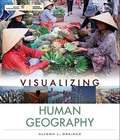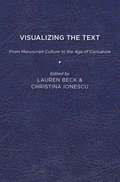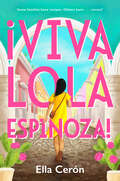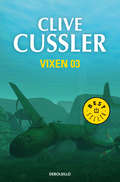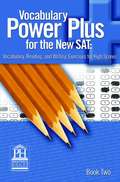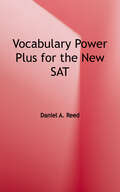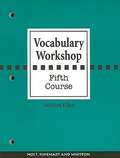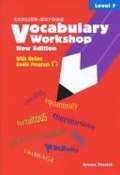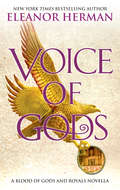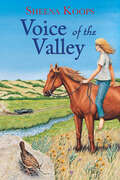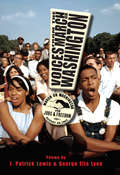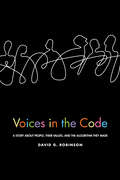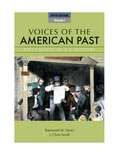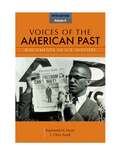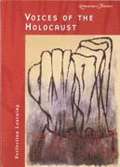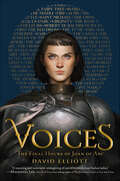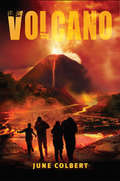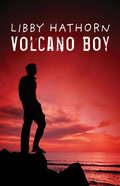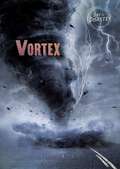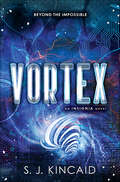- Table View
- List View
Visualizing Human Geography: At Home in a Diverse World
by Alyson L. GreinerThis book provides environmental scientists with a better understanding of global human geography because of its visual approach. The narrative and concepts are tightly linked to visual elements, including practical examples that highlight the relevance of the concepts. Maps are integrated throughout to help reveal patterns or trends. Divergent views and critical thinking are emphasized. Photographs and other visuals are also included to reinforce the concepts. With this approach, environmental scientists will gain a strong foundation for thinking geographically as they develop the skills for interpreting and analyzing their world.
Visualizing the Text: From Manuscript Culture to the Age of Caricature
by Ann Lewis Michiel Van Groesen Janine Rogers Rachel Schmidt Lauren Beck Cecilia Brain Sandra Sáenz-López Pérez Swann Paradis David McCallam Antoine EcheThis volume presents in-depth and contextualized analyses of a wealth of visual materials. These documents provide viewers with a mesmerizing and informative glimpse into how the early modern world was interpreted by image-makers and presented to viewers during a period that spans from manuscript culture to the age of caricature. The premise of this collection responds to a fundamental question: how are early modern texts, objects, and systems of knowledge imaged and consumed through bimodal, hybrid, or intermedial products that rely on both words and pictures to convey meaning? The twelve contributors to this collection go beyond traditional lines of inquiry into word-and-image interaction to deconstruct visual dynamics and politics—to show how images were shaped, manipulated, displayed, and distributed to represent the material world, to propagate official and commercial messages, to support religious practice and ideology, or to embody relations of power. These chapters are anchored in various theoretical and disciplinary points of departure, such as the history of collections and collecting, literary theory and criticism, the histories of science, art history and visual culture, word-and-image studies, as well as print culture and book illustration. Authors draw upon a wide range of visual material hitherto insufficiently explored and placed in context, in some cases hidden in museums and archives, or previously assessed only from a disciplinary standpoint that favored either the image or the text but not both in relation to each other. They include manuscript illuminations representing compilers and collections, frontispieces and other accompanying plates published in catalogues and museographies, astronomical diagrams, mixed pictographic-alphabetic accounting documents, Spanish baroque paintings, illustrative frontispieces or series inspired by or designed for single novels or anthologies, anatomical drawings featured in encyclopedic publications, visual patterns of volcanic formations, engravings representing the New World that accompany non-fictional travelogues, commonplace books that interlace text and images, and graphic satire. Geographically, the collection covers imperial centers (Great Britain, France, the Netherlands, and Spain), as well as their colonial periphery (New France; Mexico; Central America; South America, in particular Brazil; parts of Africa; and the island of Ceylon). Emblematic and thought-provoking, these images are only fragments of the multifaceted and comprehensive visual mosaic created during the early modern period, but their consideration has far reaching implications.
Visualizing the Text: From Manuscript Culture to the Age of Caricature
by Lauren Beck Christina IonescuThis volume presents in-depth and contextualized analyses of a wealth of visual materials. These documents provide viewers with a mesmerizing and informative glimpse into how the early modern world was interpreted by image-makers and presented to viewers during a period that spans from manuscript culture to the age of caricature. The premise of this collection responds to a fundamental question: how are early modern texts, objects, and systems of knowledge imaged and consumed through bimodal, hybrid, or intermedial products that rely on both words and pictures to convey meaning? The twelve contributors to this collection go beyond traditional lines of inquiry into word-and-image interaction to deconstruct visual dynamics and politics—to show how images were shaped, manipulated, displayed, and distributed to represent the material world, to propagate official and commercial messages, to support religious practice and ideology, or to embody relations of power. These chapters are anchored in various theoretical and disciplinary points of departure, such as the history of collections and collecting, literary theory and criticism, the histories of science, art history and visual culture, word-and-image studies, as well as print culture and book illustration. Authors draw upon a wide range of visual material hitherto insufficiently explored and placed in context, in some cases hidden in museums and archives, or previously assessed only from a disciplinary standpoint that favored either the image or the text but not both in relation to each other. They include manuscript illuminations representing compilers and collections, frontispieces and other accompanying plates published in catalogues and museographies, astronomical diagrams, mixed pictographic-alphabetic accounting documents, Spanish baroque paintings, illustrative frontispieces or series inspired by or designed for single novels or anthologies, anatomical drawings featured in encyclopedic publications, visual patterns of volcanic formations, engravings representing the New World that accompany non-fictional travelogues, commonplace books that interlace text and images, and graphic satire. Geographically, the collection covers imperial centers (Great Britain, France, the Netherlands, and Spain), as well as their colonial periphery (New France; Mexico; Central America; South America, in particular Brazil; parts of Africa; and the island of Ceylon). Emblematic and thought-provoking, these images are only fragments of the multifaceted and comprehensive visual mosaic created during the early modern period, but their consideration has far reaching implications.
Viva Lola Espinoza
by Ella CerónA debut young adult novel that&’s Pride & Prejudice with a dash of magic, about a booksmart teen who spends the summer in Mexico City, meets two very cute boys, attempts to learn Spanish, and uncovers a family secret that changes her life forever.Lola Espinoza is cursed in love. Well, maybe not actually cursed — magic isn't real, is it? When Lola goes to spend the summer with her grandmother in Mexico City and meets handsome, flirtatious Rio, she discovers the unbelievable truth: Magic is very real, and what she'd always written off as bad luck is actually, truly . . . a curse. If Lola ever wants to fall in love without suffering the consequences, she'll have to break the curse. She finds an unlikely curse-breaking companion in Javi, a seemingly stoic boy she meets while working in her cousin's restaurant. Javi is willing to help Lola look into this family curse of hers, and Lola needs all the help she can get. Over the course of one summer — filled with food, family, and two very different boys — Lola explores Mexico City while learning about herself, her heritage, and the magic around us all.
Vixen 03 (Dirk Pitt #4)
by Clive CusslerEn 1954, el vuelo Vixen 03 y su mortífero cargamento, un arma ultrasecreta, no llegan a su misterioso destino. La investigación oficial dictamina que el avión ha caído en el océano. En 1988, Dirk Pitt descubre restos del Vixen 03 en las heladas aguas de un río de Colorado. Parte de su cargamento ha sido sustraído por un grupo terrorista africano con intenciones de provocar una catástrofe en Washington. Pero ni siquiera los terroristas conocen las terribles consecuencias que podrían provocar con su actitud, porque muy pocas personas saben la verdad sobre el cargamento del Vixen 03.
Vocabulary Power Plus for the ACT (Book One)
by Daniel A. ReedVocabulary Power Plus for the ACT will help you: * Introduce students to the ACT test format with ACT-style multiple choice questions * Build student writing skills with practical, ACT-style writing prompts * Reinforce correct grammar usage with ACT-style exercises * Use proven techniques to help students gain skills using word-in-context questions; prefix, suffix, and root practice; inference questions; and critical reading exercises
Vocabulary Power Plus for the New SAT
by Daniel A. ReedYour students will score higher on the SAT once they've used Prestwick House's Vocabulary Power Plus for the New SAT, the only program that addresses all of the revisions in the test without compromising the vocabulary studies students need. Each unit alternates focusing on the critical reading and essay portions of the test with questions focusing on sentence completion, reading comprehension, inference, essay, root practice, and more. Review units ensure your students will remember what they've learned.
Vocabulary Power Plus for the New SAT
by Daniel A. ReedBeginning in 2005, the SAT is implementing major revisions, including: New reading sections; Analogies removed; Multiple-Choice Grammar and Usage Questions; Modified Reading Questions.Vocabulary Power Plus for the New SAT addresses all of the revisions in the test without vocabulary studies. Students will benefit from: Focused prefix, suffix, and root practice; Challenging inference exercises; Detailed critical reading exercises; New SAT-style writing and grammar exercises. Recommended for grade 11
Vocabulary Workshop, Common Core Enriched Edition, Level F
by Jerome Shostak Vicki A. Jacobs Louis P. De AngeloA publisher-supplied textbook
Vocabulary Workshop: Fifth Course
by Norbert ElliotThis book helps readers develop strategies for learning new words on their own; analyse and think about the logic of the sentence and provides opportunity to expand the readers' vocabulary.
Vocabulary Workshop: Level F (New Edition)
by Jerome ShostakPrepare students for the new standardized tests and teach 300 essential vocabulary words per level.
Vocabulary for the College-Bound Student
by Harold Levine Norman Levine Robert T. LevineTo provide meaningful, organized vocabulary improvement for the high school student whose goals may be college admission, a responsible position, or self-improvement.
Voice of Gods
by Eleanor HermanAt nineteen, Ada of Caria yearns to take the Snake Blood throne from her mad older siblings. She seeks the help of a young orphaned girl named Helen, the first True Oracle to have walked the earth in more than three hundred years.Helen may be able to channel the voice of the gods, but she hates her gift and will do anything to get rid of it--even lie to her best friend, Myrtale, the priestess-princess of Epirus who is destined to marry King Philip II of Macedon even though she loves another.And in the shadows lurks a handsome green-eyed stranger who has more at stake--and more to lose--than anyone could possibly imagine.Amid jealousy and heartbreak, torrid affairs and secret rendezvous, it is spoken by the gods that either Helen or Myrtale--newly named Olympias--will carry the destiny of the known world within her womb.The prequel to Legacy of Kings, Voice of Gods traces the intricate web of love and betrayal that led up to the birth of history's most powerful leader, Alexander the Great.
Voice of the Valley
by Sheena KoopsVoice of the Valley is a poetic, multi-layered, coming-of-age story inspired by the controversial flooding of Saskatchewan's Souris Valley. Onja Claibourn is almost fifteen. Her world is one of sage, buffalo bills, brown-eyed susans, cactus, flax, buckbrush, foxtail and orange moss—the world of the valley just beyond the family farm. Old roads twist like a game of snakes and ladders into the valley. Onja and her horse Ginger spend their summer days in exploration. But things begin to change when Onja discovers first an archeological dig and then the startling fact that there is a plan to dam and flood her valley. She cannot contemplate this change to the landscape she loves so much. And when she also discovers sixteen-year-old Etthen, working with the archaeologists, she begins those first faltering footsteps toward a totally unfamiliar landscape—romantic love. Onja Claibourn is a wonderfully complex and very real character—innocent, wise, shy, stubborn, playful, and caring. The other major character in the novel is the prairie landscape itself—huge sky, harsh sun, rolling hills, sweeping fields of grain.
Voices from the March on Washington
by George Ella Lyon J. Patrick LewisThe powerful poems in this poignant collection weave together multiple voices to tell the story of the March on Washington, DC, in 1963. From the woman singing through a terrifying bus ride to DC, to the teenager who came partly because his father told him, "Don't you dare go to that march," to the young child riding above the crowd on her father's shoulders, each voice brings a unique perspective to this tale. <P><P> As the characters tell their personal stories of this historic day, their chorus plunges readers into the experience of being at the march--walking shoulder-to-shoulder with strangers, hearing Martin Luther King Jr.'s famous speech, heading home inspired.
Voices in the Code: A Story about People, Their Values, and the Algorithm They Made
by David G. RobinsonAlgorithms—rules written into software—shape key moments in our lives: from who gets hired or admitted to a top public school, to who should go to jail or receive scarce public benefits. Such decisions are both technical and moral. Today, the logic of high stakes software is rarely open to scrutiny, and central moral questions are often left for the technical experts to answer. Policymakers and scholars are seeking better ways to share the moral decisionmaking within high stakes software—exploring ideas like public participation, transparency, forecasting, and algorithmic audits. But there are few real examples of those techniques in use. In Voices in the Code, scholar David G. Robinson tells the story of how one community built a life-and-death algorithm in an inclusive, accountable way. Between 2004 and 2014, a diverse group of patients, surgeons, clinicians, data scientists, public officials and advocates collaborated and compromised to build a new kidney transplant matching algorithm—a system to offer donated kidneys to particular patients from the U.S. national waiting list. Drawing on interviews with key stakeholders, unpublished archives, and a wide scholarly literature, Robinson shows how this new Kidney Allocation System emerged and evolved over time, as participants gradually built a shared understanding both of what was possible, and of what would be fair. Robinson finds much to criticize, but also much to admire, in this story. It ultimately illustrates both the promise and the limits of participation, transparency, forecasting and auditing of high stakes software. The book’s final chapter draws out lessons for the broader struggle to build technology in a democratic and accountable way.
Voices of the American Past: Documents in U.S. History, Volume I
by Raymond M. Hyser J. Chris ArndtNIMAC-sourced textbook
Voices of the American Past: Documents in U.S. History, Volume II
by Raymond M. Hyser J. Chris ArndtNIMAC-sourced textbook
Voices of the Holocaust
by Perfection Learning CorporationContains short stories, poems, biographical accounts, and essays about the Holocaust intended to help readers answer the question: Could a holocaust happen here?
Voices: The Final Hours of Joan of Arc
by David Elliott"Stunning . . . elegant . . . arresting . . . supple and harrowing.” - The Wall Street Journal★“An innovative, entrancing account of a popular figure that will appeal to fans of verse, history, and biography.” - Kirkus, starred reviewIn poems that surprise and move readers, bestselling author David Elliott explores how Joan of Arc changed the course of history and remains a figure of fascination centuries after her extraordinary life and death.Told through medieval poetic forms and in the voices of the people and objects in Joan of Arc’s life, (including her family and even the trees, clothes, cows, and candles of her childhood), Voices offers an unforgettable perspective on an extraordinary young woman. Along the way it explores timely issues such as gender, misogyny, and the peril of speaking truth to power. Before Joan of Arc became a saint, she was a girl inspired. It is that girl we come to know in Voices.
Volcano
by June ColbertSara is fifteen and secretly in love with Kel Pearson. Her dad is a Meatball. Kel?s dad is a Meatball too. `Meatballs? like to jump into earthquakes and climb inside volcanoes to take their temperatures. When they clamber out, shoes burning and hair smoking, they pass their findings on to Coneheads. `Coneheads? analyse data and make recommendations to local governments. Together they make up an `AusDAR? team ? Disaster Assessment and Relief (Australian Division) ? experts in Disaster Casualty Minimisation. They?ve just been asked to go to the exotic Andes to gauge the safety of the new gas and oil pipeline being dug through the base of a sleepy little extinct volcano called Mt Cumbal. They are all set for the adventure of a lifetime ? after all, the volcano is in no danger of erupting. But what about that murky, brown water coming out of the tap in Sara?s caravan? It?s not supposed to smell like sulphur ? June Colbert, bestselling author of THE KING OF LARGE and THE LAST BOY, masterfully weaves together teenage themes of identity, pride, secret `crushes? and the sense of belonging in her well-researched, detailed and fast-paced novel VOLCANO.
Volcano Boy
by Libby HathornA powerful verse novel from one of Australia's favourite authors.Alone and grieving, Alexander feels ready to erupt. Can he find his way back to hope?'A real volcano boy,' his mother had called him.Placed in the custody of his puritanical but well-meaning Uncle Frank, Alexander moves from Brisbane to volcano-circled Rabaul in Papua New Guinea. There the dark powers of the rumbling volcano call to him as irresistibly as the dark eyes of Alice, his newfound love. Alexander records his experiences in a moving, candid journal that surfaces many years after the volcano's fury has settled to ash.'VOLCANO BOY is beautifully written, and Hathorn is a beautiful writer.' - LITERATURE CAFECelebrating 25 years of Libby Hathorn, acclaimed author of the Australian young adult classic THUNDERWITH. 'Hathorn deftly injects a sense of wonderment into this intense, very real story. Readers cannot help but be swept up on the action and emotion.' - PUBLISHERS WEEKLY on THUNDERWITH
Vortex (Day of Disaster)
by Vanessa ActonBlair and her brothers are driving home from a disastrous road trip when their day suddenly gets a whole lot worse. After facing down a tornado, their car is barely functioning, and the same can be said for Blair's older brother. Blair must take charge and get her family out of danger, but the storm isn't letting up. Will Blair be able to get her injured and scared brothers to safety . . . before the next twister hits?
Vortex (The Insignia Novels #2)
by S. J. KincaidS. J. Kincaid has created a fascinating dystopian world for Insignia, her futuristic science-fiction adventure series perfect for fans of Ender's Game. Earth is in the middle of WWIII, a war to determine which governments and corporations will control the resources of the solar system.Teen Tom Raines grew up with nothing—some days without even a roof over his head. Then his exceptional gaming skills earned him a spot in the Intrasolar Forces, the country's elite military training program, and his life completely changed.Now in Vortex, the second book in the series, Tom discovers that the Pentagonal Spire, where he and his friends are being trained as superhuman weapons, is filled with corruption. He is asked to betray his friends—the first real friends he's ever had—for the sake of his country.Will he sacrifice his new life to do what he believes is right?
